Shilin Xiao
Fast and accurate waveform modeling of long-haul multi-channel optical fiber transmission using a hybrid model-data driven scheme
Jan 18, 2022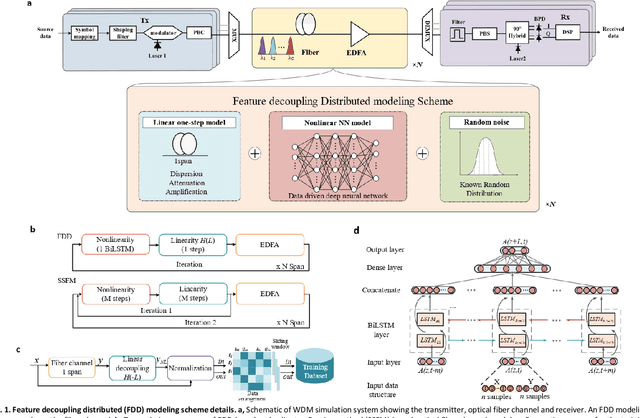

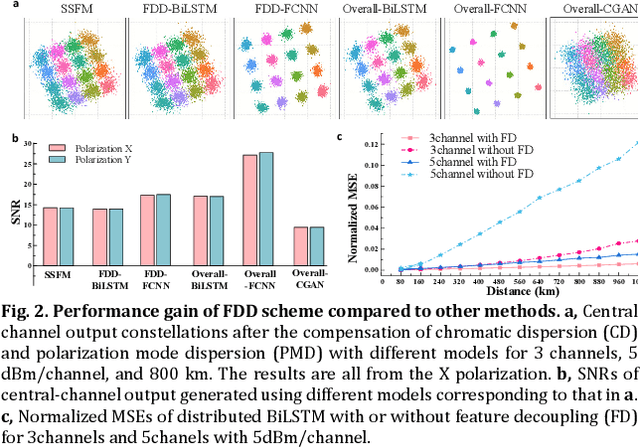
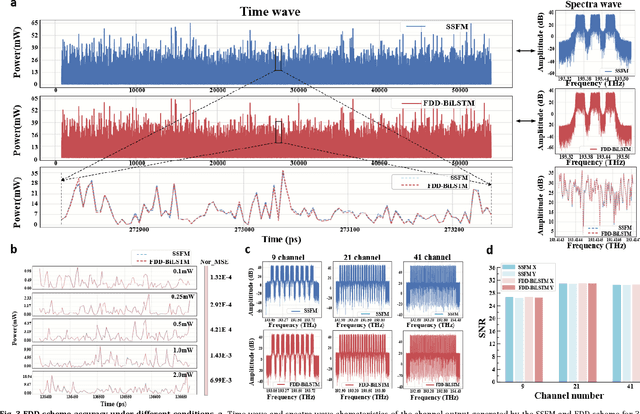
Abstract:The modeling of optical wave propagation in optical fiber is a task of fast and accurate solving the nonlinear Schr\"odinger equation (NLSE), and can enable the optical system design, digital signal processing verification and fast waveform calculation. Traditional waveform modeling of full-time and full-frequency information is the split-step Fourier method (SSFM), which has long been regarded as challenging in long-haul wavelength division multiplexing (WDM) optical fiber communication systems because it is extremely time-consuming. Here we propose a linear-nonlinear feature decoupling distributed (FDD) waveform modeling scheme to model long-haul WDM fiber channel, where the channel linear effects are modelled by the NLSE-derived model-driven methods and the nonlinear effects are modelled by the data-driven deep learning methods. Meanwhile, the proposed scheme only focuses on one-span fiber distance fitting, and then recursively transmits the model to achieve the required transmission distance. The proposed modeling scheme is demonstrated to have high accuracy, high computing speeds, and robust generalization abilities for different optical launch powers, modulation formats, channel numbers and transmission distances. The total running time of FDD waveform modeling scheme for 41-channel 1040-km fiber transmission is only 3 minutes versus more than 2 hours using SSFM for each input condition, which achieves a 98% reduction in computing time. Considering the multi-round optimization by adjusting system parameters, the complexity reduction is significant. The results represent a remarkable improvement in nonlinear fiber modeling and open up novel perspectives for solution of NLSE-like partial differential equations and optical fiber physics problems.
Maximizing Revenue with Adaptive Modulation and Multiple FECs in Flexible Optical Networks
Jun 14, 2021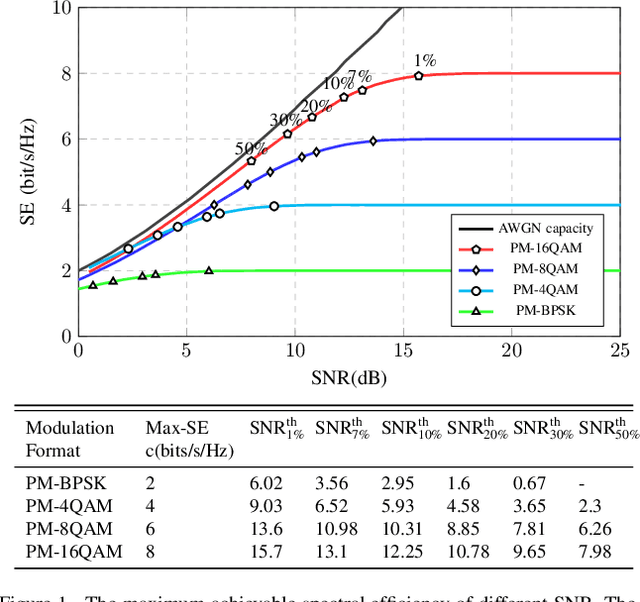
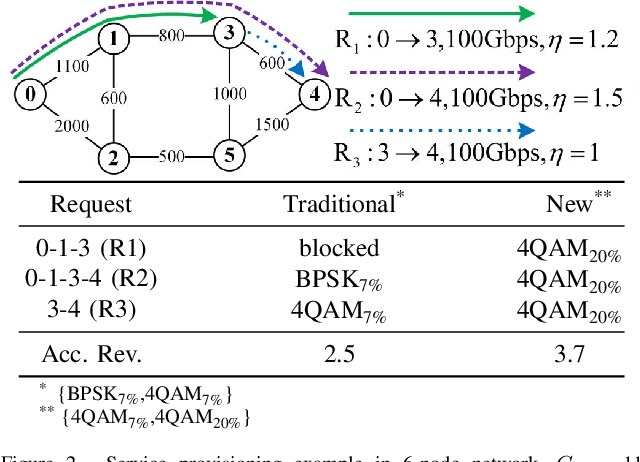


Abstract:Flexible optical networks (FONs) are being adopted to accommodate the increasingly heterogeneous traffic in today's Internet. However, in presence of high traffic load, not all offered traffic can be satisfied at all time. As carried traffic load brings revenues to operators, traffic blocking due to limited spectrum resource leads to revenue losses. In this study, given a set of traffic requests to be provisioned, we consider the problem of maximizing operator's revenue, subject to limited spectrum resource and physical layer impairments (PLIs), namely amplified spontaneous emission noise (ASE), self-channel interference (SCI), cross-channel interference (XCI), and node crosstalk. In FONs, adaptive modulation, multiple FEC, and the tuning of power spectrum density (PSD) can be effectively employed to mitigate the impact of PLIs. Hence, in our study, we propose a universal bandwidth-related impairment evaluation model based on channel bandwidth, which allows a performance analysis for different PSD, FEC and modulations. Leveraging this PLI model and a piecewise linear fitting function, we succeed to formulate the revenue maximization problem as a mixed integer linear program. Then, to solve the problem on larger network instances, a fast two-phase heuristic algorithm is also proposed, which is shown to be near-optimal for revenue maximization. Through simulations, we demonstrate that using adaptive modulation enables to significantly increase revenues in the scenario of high signal-to-noise ratio (SNR), where the revenue can even be doubled for high traffic load, while using multiple FECs is more profitable for scenarios with low SNR.
Throughput Maximization Leveraging Just-Enough SNR Margin and Channel Spacing Optimization
Jun 14, 2021



Abstract:Flexible optical network is a promising technology to accommodate high-capacity demands in next-generation networks. To ensure uninterrupted communication, existing lightpath provisioning schemes are mainly done with the assumption of worst-case resource under-provisioning and fixed channel spacing, which preserves an excessive signal-to-noise ratio (SNR) margin. However, under a resource over-provisioning scenario, the excessive SNR margin restricts the transmission bit-rate, leading to physical layer resource waste and stranded transmission capacity. To tackle this challenging problem, we leverage an iterative feedback tuning algorithm to provide a just-enough SNR margin, so as to maximize the network throughput. Specifically, the proposed algorithm is implemented in three steps. First, starting from the high SNR margin setup, we establish an integer linear programming model as well as a heuristic algorithm to maximize the network throughput by solving the problem of routing, modulation format, forward error correction, baud-rate selection, and spectrum assignment. Second, we optimize the channel spacing of the lightpaths obtained from the previous step, thereby increasing the available physical layer resources. Finally, we iteratively reduce the SNR margin of each lightpath until the network throughput cannot be increased. Through numerical simulations, we confirm the throughput improvement in different networks and with different baud-rates. In particular, we find that our algorithm enables over 20\% relative gain when network resource is over-provisioned, compared to the traditional method preserving an excessive SNR margin.
Optical Fiber Channel Modeling Using Conditional Generative Adversarial Network
Feb 28, 2020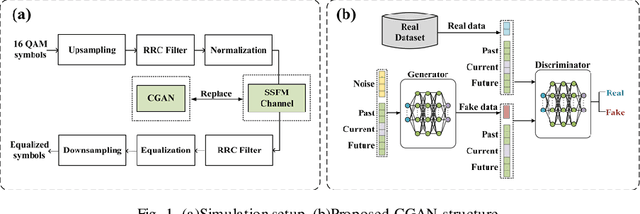

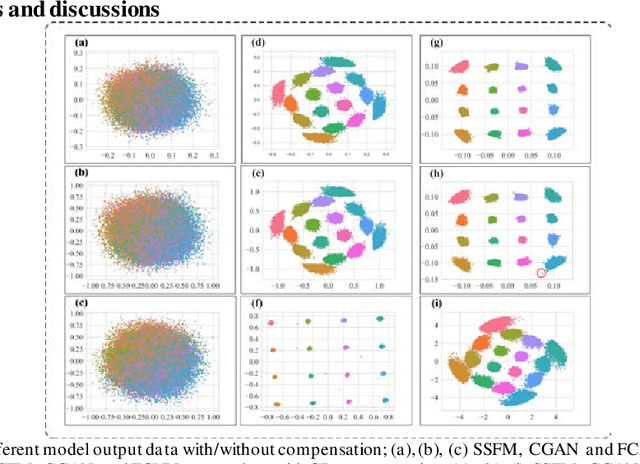
Abstract:In this paper, we use CGAN (conditional generative adversarial network) to model the fiber-optic channel and the performance is similar with the conventional method, SSFM (split-step Fourier method), while the running time is reduced from several minutes to about 2 seconds at 80-km distance.
 Add to Chrome
Add to Chrome Add to Firefox
Add to Firefox Add to Edge
Add to Edge